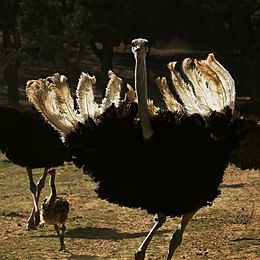Ostrich feather
Ostrich feathers (also known as ostrich feathers ) are the feathers of the African ostrich ( Struthio camelus ). In particular, the white tail feathers of the roosters and the white hand wings on the wing tips of ostriches of both sexes are understood. For a long time, these were coveted as decorative accessories and were considered to be the “most exquisite decorative feathers”.
function
Ostriches are unable to fly. Their feathers could therefore take on other functions in the course of evolution. The roosters have black plumage and white splendid or decorative feathers on both the wing tips and the tail. The gray-brown feathered hens also have white feathers on the wing tips and gray-brown feathers on the tail.
The decorative feathers were formed in the course of evolution from the flywheel and control feathers that had become inoperable after the loss of flight ability . By spreading the wings, the feathers on the wing tips also function as a source of shade when it is very hot.
use
antiquity
Ostrich feathers have been a popular ornament since ancient times . As early as the 2nd century BC BC the hunt for ostriches can be proven.
The Egyptian hieroglyph
|
Modern times

In Europe, in the 18th century, ostrich feathers became so fashionable as hat decoration, especially among wealthy women, that the hunt for birds reached such proportions that the species was soon threatened. As a decorative accessory, naturally white ostrich feathers were particularly popular.
After wild ostriches had become extremely rare at the beginning of the 19th century, these animals began to be bred. The first ostrich farm was established in South Africa in 1838. In breeding, the focus was on selecting good quality feathers. With the First World War, the spring trade collapsed; today the extraction of ostrich feathers only plays a subordinate role in ostrich farming.
Due to their electrostatic properties, ostrich feathers are still used today for the production of feather dusters or technical brushes .
Beret of a nobleman of the 16th century with an ostrich feather
Fan made of ostrich feathers (around 1920)
heraldry
The ostrich feather also appeared in heraldry in the 18th and 19th centuries and was mainly used as a helmet jewel , and more rarely as a common figure . Ostrich feathers are used as crests , especially in Polish heraldry and on the coats of arms of German student associations .
In Napoleonic heraldry , the previous crowns of rank were replaced by a system of hats in which, among other things, the number of ostrich feathers represented the status of the wearer. The chevaliers wore one pen, barons three, counts five and dukes seven.
Badge of the Prince of Wales with ostrich feathers
Coat of arms of the municipality of Sarleinsbach
Polish Coat of Arms with ostrich feathers as a crest and a Common Figure
Student coat of arms with ostrich feathers in connecting colors
See also
literature
- Ostrich feathers. In: Pierer's Universal-Lexikon , Volume 16. Altenburg 1863, p. 914. ( Online )
- Peter Behrens: ostrich feather. In: Wolfgang Helck , Eberhard Otto, Wolfhart Westendorf (eds.): Lexicon of Egyptology. Volume VI: Stele - Cypress . Otto Harrassowitz Verlag, Wiesbaden 1986. ISBN 3-447-02663-4 . Pp. 77-81.
Web links
Individual evidence
- ^ Meyers Großes Konversations-Lexikon: "Federn" , Volume 6. Leipzig 1906, pp. 374–376.
- ↑ Anja-Christin Schulz: Studies on the behavior and keeping of African ostriches (Struthio camelus) under German climatic conditions (PDF file; 2.36 MB). Inaugural dissertation, Veterinary Faculty of the Ludwig Maximilians University, Munich 2004. p. 3.
- ↑ Anja-Christin Schulz: Studies on the behavior and keeping of African ostriches (Struthio camelus) under German climatic conditions (PDF file; 2.36 MB). Inaugural dissertation, Veterinary Faculty of the Ludwig Maximilians University, Munich 2004. p. 23.
- ↑ Anja-Christin Schulz: Studies on the behavior and keeping of African ostriches (Struthio camelus) under German climatic conditions (PDF file; 2.36 MB). Inaugural dissertation, Veterinary Faculty of the Ludwig Maximilians University, Munich 2004. p. 4.
- ↑ Wolfgang Helck, Eberhard Otto, Wolfhart Westendorf (ed.): Lexicon of Egyptology. Volume VI. Stele - cypress. Otto Harrassowitz Verlag, Wiesbaden 1986. ISBN 3-447-02663-4 . P. 77.
- ↑ Anja-Christin Schulz: Studies on the behavior and keeping of African ostriches (Struthio camelus) under German climatic conditions (PDF file; 2.36 MB). Inaugural dissertation, Veterinary Faculty of the Ludwig Maximilians University, Munich 2004. p. 2.
- ↑ Otto Titan von Hefner: Handbook of theoretical and practical heraldry , Heraldisches Institut, Munich 1861. P. 81.
- ↑ Gerhard Richwien: “The legacy of the orders. Symbolic world of the Enlightenment and knightly identification patterns in academic corporations, ”. In: Erich Donnert (Hrsg.): Europe in the early modern times: Festschrift for Günter Mühlpfordt. Volume 6: Central, Northern and Eastern Europe. Böhlau, Cologne 2002. ISBN 3-412-14799-0 . P. 627 ff., Here: P. 637.












